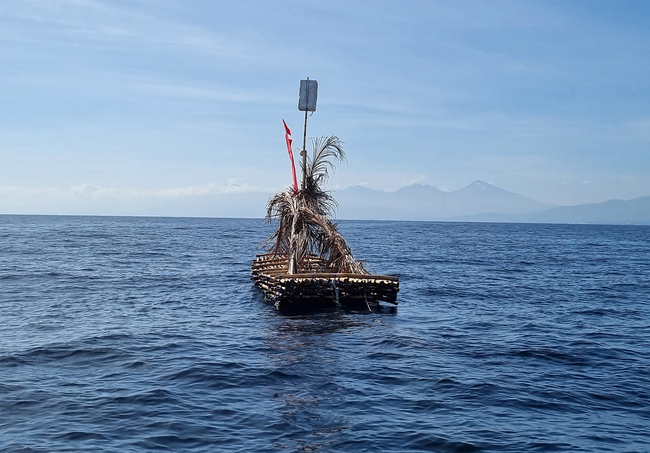15/08/2024 | Biodiversity is challenging to observe and assess in the open ocean, which is vast and difficult to access. The European research project "Monitoring the Open-Ocean Biodiversity with Fishers" (MOOBYF) is now pursuing a new strategy for which it draws on ZMT’s deep-rooted collaboration with the local population that lives from fishing in the Indian Ocean. The researchers will use anchored rafts, or fish aggregating devices (FADs) used by local fishermen, to record the occurrence of various pelagic fish species. In addition to ZMT, seven research institutions from six countries are involved in the project, which is being funded with more than one million Euros as part of the European BiodivERsA+ programme.
Pelagic ecosystems, which comprise marine organisms and environmental features of the open ocean, are among the largest ecosystems on Earth. Human activities and climate change are putting them under increasing stress. At the same time, however, they play a crucial role for humans – for example as a source of food or for climate regulation. Against this complex backdrop, what is the situation regarding the state of pelagic species? That is what the MOOBYF research project is trying to answer in close dialogue with local fishermen in the Indian Ocean.
Artificial rafts as observation posts
Thousands of so-called "Fish Aggregating Devices“ (FADs) are floating in the Indian Ocean off Indonesia, the Maldives and the French overseas department of Mayotte, – some of them on anchor lines that can be several hundred metres long. These devices in the open ocean are deployed and maintained by fishermen. "The fishermen take advantage of the fact that around 20 pelagic species, including tuna, are attracted to these floating structures in the water and congregate near them," explains reef ecologist Dr. Sebastian Ferse, who is coordinating part of the project together with social scientist Dr. Annette Breckwoldt at ZMT.
However, this aggregation behaviour of fish around the artificial rafts not only helps the fishermen, but also the researchers. "The idea is to use the FADs in these three areas as monitoring platforms for biodiversity research in close cooperation with the fishermen," says Ferse. The observation techniques range from molecular ecology and underwater acoustics to underwater videos, supported by the use of artificial intelligence for species identification. "We want to share the results among the project partners and compare them with local knowledge," says Ferse.
Cooperation and knowledge exchange
By involving local fishers, the aim is to jointly organise biodiversity monitoring and to enter into a constant exchange of knowledge, thus employing a citizen science approach which is central to the project. But it is by no means just a dialogue between the researchers and the fishermen. "In the Maldives and Indonesia, cooperative links with fishermen have existed for a very long time," explains Annette Breckwoldt. The MOOBYF project can build on this trusting cooperation and aims to connect fishermen transnationally and thus strengthen them. "For more sustainable fishing and the long-term protection of biodiversity in the open ocean, it is crucial that the voices of fishermen are heard in the context of local politics and that their knowledge is taken seriously," says Breckwoldt.
In addition to the Leibniz Centre for Tropical Marine Research (ZMT), other partners from a total of six countries – France, Germany, Italy, Belgium, the Maldives and Indonesia – are involved in the three-year MOOBYF project. These include: Institut de recherche pour le développement - IRD (coordination), Badan Riset dan Inovasi Nasional RI (BRIN RI), Marine Research Centre (MRC, Maldives), Consiglio Nazionale delle Ricerche (CNR), Università degli Studi di Padova and the Université de Liège.





